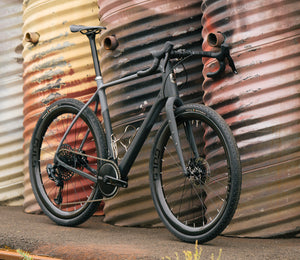Boost Chainline and 1x Boost Chainring Selection
Boost spacing is here and quickly propagating across many bikes. Wolf Tooth wanted to level set everyone on what Boost means to chainline and chainring selection for 1x drivetrains. Note that there are other issues with widening the rear hub spacing on 2x or 3x front shifting drivetrains that are covered well by BikeRumor and this won't be discussed here.
For those not familiar with what "Boost" is, it really just refers to a widening of the axles on mountain bikes. From 100mm to 110mm in the front and 142mm to 148mm in the back. The increase of "only" 6mm in the rear axle (3 on each side) was chosen because in most cases it is as wide as the axle can get without going to wider Q-factor cranksets (Q-factor is how far apart the mounting face for the pedals are). Along with the wider rear axle, the cassette shifts out 3mm. Now that you know what Boost is, also know that boost is used for 2 very different reasons:
- First and foremost it was brought about to allow adequate chain clearance for plus-sized tires, or not-quite-fat tires that are ~2.8"-3.5".
- Increased wheel stiffness, especially on 29ers, by increasing the bracing angle of the spokes. Trek was the first big bike company to do this and they claim a 15-20% increase in 29er wheel stiffness.
If you want the simplest answer for chainring selection, get a boost spaced chainring if you have a boost spaced rear hub. Wolf Tooth makes boost spaced rings for most cranks.
If you want to dig in a little more keep reading!
With the 3mm outward cassette move, one might think that a chainline move is imperative (chainline is how far the front chainrings are from the centerline of the bike). However there are actually only 3 situations where a a boost spaced chainring, 3mm further out than "standard", is required. For other situations, a non-boost ring might work well or even better for you! 3 Reasons that you MUST use boost:
- If you are running 12 speed, the clearances are so small between chain and cassette that you MUST run a boost spaced chainring with a boost spaced bike. If you don't, the chain will "tick" on the next bigger cog when in the smallest 2-3 cogs on the cassette.
- Most plus sized tire bikes do need a 3mm outward chainring shift to maintain the "standard" 6mm distance between tire and chain. To be sure, plenty of riders including the Wolf Tooth crew have run less tire clearance on our fat bikes when in the largest cassette cogs, but there is liability there so it is not allowed on production bikes and we can't endorse it.
- If on a standard Boost bike, i.e not a plus-sized tire bike, there is not adequate chainring clearance to the chainstay. This is becoming more and more common on modern bikes (starting in about 2016). Again, if you just want to be safe, buy a boost spaced chainring. We don't like to go less than 3mm clearance between chainstay and chainring, and you can contact the bike frame manufacture to see what their frames allow for chainring clearance and chainline.
Going further with geometry and chainline, you will see that there is more to it...
You might as, "Wait a minute. The centerline of a 10 speed cassette is roughly 45 mm, and the center of 11 speed cassette is ~44mm from the centerline of a bike. Why isn't that used as the chainline?" Well, for proper shifting on a 1x setup you want to be at least ~2 mm to the outside (towards the small cogs) otherwise the chain will catch on the next bigger cogs when pedaling in the smaller cogs. So a perfect 1x with minimal cross-chaining in the big cassette cogs is 46-47mm. You might ask why SRAM designed a dedicated 1x drivetrain around a 49-50mm chainline, and the answer is very simple: most bikes would only clear about a 28t chainring at a chainline that narrow and the most popular 1x sized chainring is a 32t with many riders wanting 34t and 36t options. To put another way, across a very broad range of frames a chainline more narrow than about 49mm won't have adequate chainring clearance for the chainrings most people ride.

Coming back around to Boost, you can do the math quickly that for 10 speed 45mm centerline + 2mm shift towards the small cogs + 3mm boost shift = 50mm and for 11 speed 44mm+2mm+3mm = 49mm for the center of a Boost rear hub's cassette. The ideal boost chainline is actually ~49-50mm if you have adequate chainstay clearance and don't run plus-sized tires. This means that in most cases the current Wolf Tooth Drop Stop (TM) chainrings are perfectly suited for Boost rear hub bikes. The reason we don't make 46-47mm chainline rings for non-boost bikes is that most bikes have inadequate chain clearance for "average" sized chainrings (30t-32t) at that narrow chainline.
A final note is that Wolf Tooth will also be producing "Boost" spaced chainrings as the plus-bike market and those bikes that need the chainstay clearance grows.



